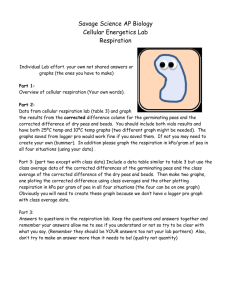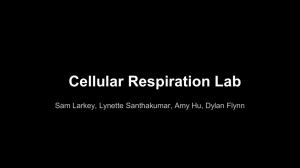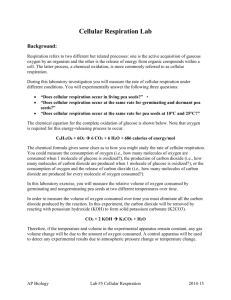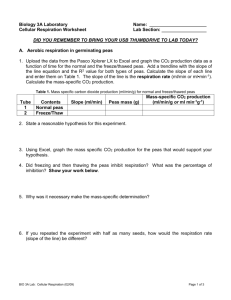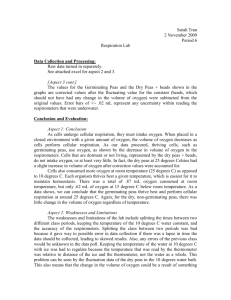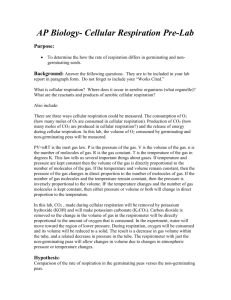Lesson Plan for Cellular Respiration Lab
advertisement
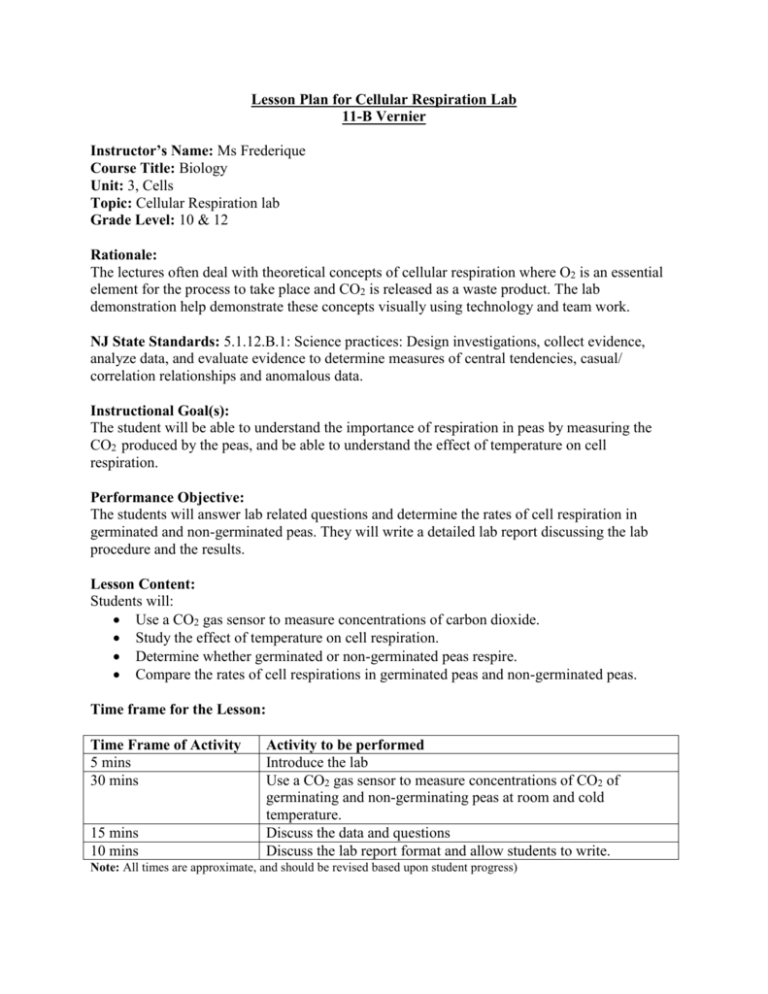
Lesson Plan for Cellular Respiration Lab 11-B Vernier Instructor’s Name: Ms Frederique Course Title: Biology Unit: 3, Cells Topic: Cellular Respiration lab Grade Level: 10 & 12 Rationale: The lectures often deal with theoretical concepts of cellular respiration where O2 is an essential element for the process to take place and CO2 is released as a waste product. The lab demonstration help demonstrate these concepts visually using technology and team work. NJ State Standards: 5.1.12.B.1: Science practices: Design investigations, collect evidence, analyze data, and evaluate evidence to determine measures of central tendencies, casual/ correlation relationships and anomalous data. Instructional Goal(s): The student will be able to understand the importance of respiration in peas by measuring the CO2 produced by the peas, and be able to understand the effect of temperature on cell respiration. Performance Objective: The students will answer lab related questions and determine the rates of cell respiration in germinated and non-germinated peas. They will write a detailed lab report discussing the lab procedure and the results. Lesson Content: Students will: Use a CO2 gas sensor to measure concentrations of carbon dioxide. Study the effect of temperature on cell respiration. Determine whether germinated or non-germinated peas respire. Compare the rates of cell respirations in germinated peas and non-germinated peas. Time frame for the Lesson: Time Frame of Activity 5 mins 30 mins 15 mins 10 mins Activity to be performed Introduce the lab Use a CO2 gas sensor to measure concentrations of CO2 of germinating and non-germinating peas at room and cold temperature. Discuss the data and questions Discuss the lab report format and allow students to write. Note: All times are approximate, and should be revised based upon student progress) Instructional procedures: a. Focusing event –Students will be asked to define the cellular respiration equation. b. Bridge/ Connections – Students will be asked about how they get their energy to do work like exercises, walking, studying, etc. They will be asked to relate that to the cellular respiration equation. c. Teaching procedures – The students will be working in groups (3 students/group). They will collectively answer the initial questions which will lead into the lab activity. During the lab, the teacher will provide assistance by doing demonstrations, answer any questions, etc. After, the lab activity, the students will be asked to answer questions as a group and there will be a class discussion. d. Formative check – The teacher will be observing for independence of the student to perform the experiment accurately. In addition, the teacher will question students while they are doing the lab to see if they understand it. For instance, asking them the rationale behind using non germinating and germinating peas. If majority of the students struggle, the teacher will have to go over the topics again but this time more thoroughly. e. Student participation- The students will be working in pairs and answering questions together. The group will be getting participation grade if they answer questions during the discussion. f. Interdisciplinary connections – This activity integrates technology with science. The students will learn to appreciate the ease of data collection. g. Closure- After lab activity, there will be a discussion of the lab results and questions. The teacher brings up the cellular respiration equation again for showing the relevance to the lab activity. Evaluation Procedure: The student evaluations will be done based on in class discussions and their lab reports. If majority of the class lacks the understanding of the concepts, the teacher needs to spend more time explaining the topic and slowly re-demonstrating the experiment and its importance. Materials and Aids: The lab will require CO2 sensor, 2 laptops, LoggerPro software, 2-100mL beakers, 1- 250mL cellular respiration chamber, germinating peas, non-germinating peas, ice, water, thermometer and paper towels.

